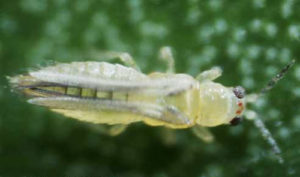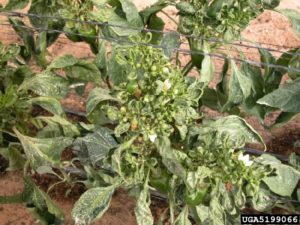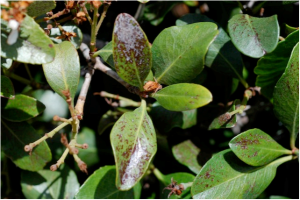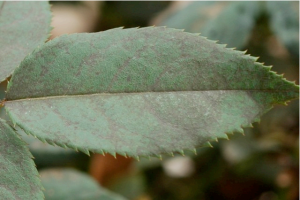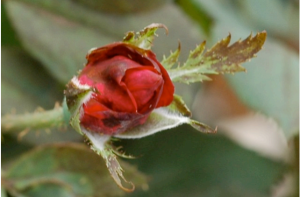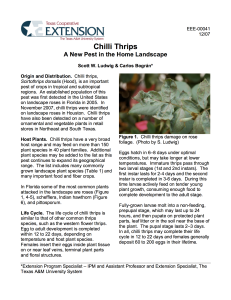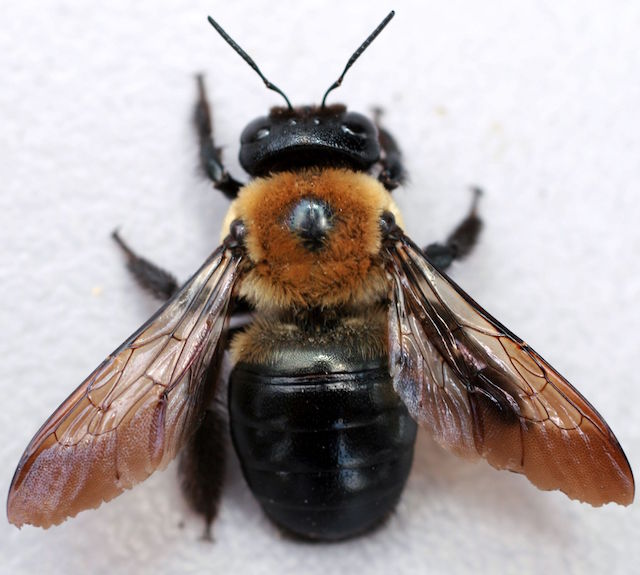
Adult chilli thrips. Photo: Andrew Derksen, USDA-APHIS, Bugwood.org
Most recently reviewed by: Extension Entomologist at Overton (2018)
Common Name(s): Chilli Thrips
Pest Location
Landscape Ornamental, Greenhouse Ornamental and Nursery, Vegetable and FruitDescription
Chilli thrips are extremely small and difficult to distinguish from other thrips species without the aid of a compound microscope. Adults are pale with dark wings and less than 2 mm in length. Immature chilli thrips are also pale in color and resemble the immatures of many other thrips species. Infestations by chilli thrips are usually first detected in the landscape by the distinctive damage caused to the host plants. Unlike flower thrips, that feed primarily on pollen, chilli thrips feed on various plant tissues. Feeding causes leaf, bud, and fruit bronzing (tissues turn bronze in color). Damaged leaves may curl upward and appear distorted. Infested plants become stunted or dwarfed and leaves may detach from the stem at the petioles in some plant species. Feeding may also cause buds to become brittle and drop. Young leaves, buds and fruits are preferred, although all above ground parts of their host plants may be attacked. Plants with the symptoms described above should be examined closely for the presence of thrips.
- Adult Chilli Thrips. Photo: Lance Osborne, Entomology and Nematology Department, University of Florida.
- Chilli thrips damage causing curling of leaves. Photo: Florida Division of Plant Industry, Florida Department of Agriculture and Consumer Services, Bugwood.org.
Origin and Distribution
Chilli thrips, Scirtothrips dorsalis (Hood), is an important pest of crops in tropical and subtropical regions. An established population of this pest was first detected in the United States on landscape roses in Florida in 2005. In November 2007, chilli thrips were identified on landscape roses in Houston. Chilli thrips have also been detected on a number of ornamental and vegetable plants in retail stores in Northeast and South Texas.
Habitat & Hosts
Chilli thrips have a very broad host range and may feed on more than 150 plant species in 40 plant families. Additional plant species may be added to the list as this pest continues to expand its geographical range. The list includes many commonly grown landscape plant species (Table 1) and many important food and fiber crops. In Florida some of the most common plants attacked in the landscape are roses (Figure 1, 4-5), schefflera, Indian hawthorn (Figure 6), and pittosporum.
- Discoloration caused by chili thrips. Texas A&M AgriLife Extension.
- Discoloration caused by chili thrips. Texas A&M AgriLife Extension.
- Leaf curl as a result of chilli thrips infestation. Texas A&M AgriLife Extension.
- Chilli thrips damage. Texas A&M AgriLife Extension
Life Cycle
The life cycle of chilli thrips is similar to that of other common thrips species, such as the western flower thrips. Egg to adult development is completed within 12 to 22 days, depending on temperature and host plant species. Females insert their eggs inside plant tissue on or near leaf veins, terminal plant parts and floral structures. Eggs hatch in 6–8 days under optimal conditions, but may take longer at lower temperatures. Immature thrips pass through two larval stages (1st and 2nd instars). The first instar lasts for 2-4 days and the second instar is completed in 3-6 days. During this time larvae actively feed on tender young plant growth, consuming enough food to complete development to the adult stage. Fully-grown larvae molt into a non-feeding, prepupal stage, which may last up to 24 hours, and then pupate on protected plant parts, leaf litter or in the soil near the base of the plant. The pupal stage lasts 2–3 days. In all, chilli thrips may complete their life cycle in 12 to 22 days and females generally deposit 60 to 200 eggs in their lifetime.
